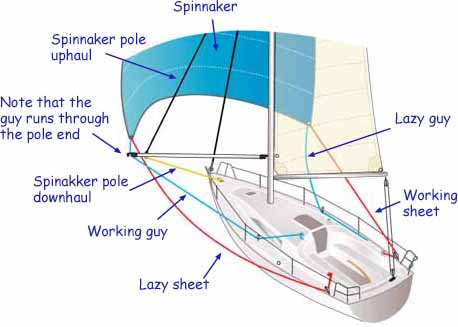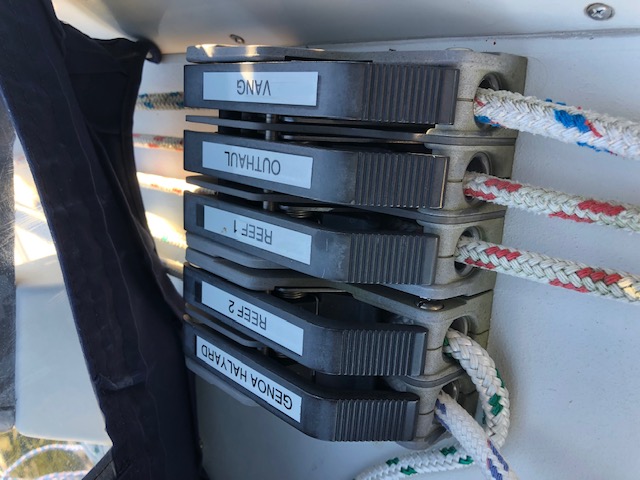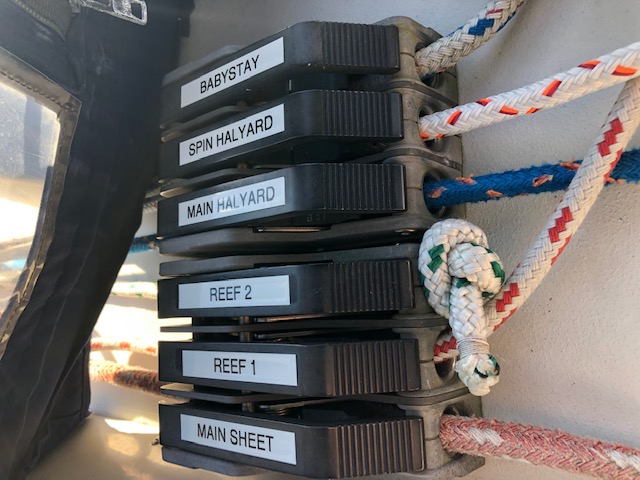Sailboat Rigging
Part 2: Running Rigging
Sailboat rigging can be described as being either running rigging which is adjustable and controls the sails - or standing rigging, which fixed and is there to support the mast. And there's a huge amount of it on the average cruising boat...
 And you'll need a whole lot more of it if you fly a spinnaker!
And you'll need a whole lot more of it if you fly a spinnaker!- Port and starboard sheets for the jib, plus two more for the staysail (in the case of a cutter rig) plus a halyard for each - that's 6 separate lines;
- A mainsheet, halyard, kicker, clew outhaul, topping lift and probably three reefing pennants for the mainsail (unless you have an in-mast or in-boom furling system) - 8 more.
Total? 23 separate lines for a cutter-rigged boat, 18 for a sloop. Either way, that's a lot of string for setting and trimming the sails.
 Coachroof mounted jammers on the portside of the main hatch
Coachroof mounted jammers on the portside of the main hatch More control line jammers on the starboardside of the main hatch
More control line jammers on the starboardside of the main hatchMany skippers prefer to have all running rigging brought back to the cockpit - clearly a safer option than having to operate halyards and reefing lines at the mast. The downside is that the turning blocks at the mast cause friction and associated wear and tear on the lines.
The Essential Properties of Lines for Running Rigging
It's often under high load, so it needs to have a high tensile strength and minimal stretch.
It will run around blocks, be secured in jammers and self-tailing winches and be wrapped around cleats, so good chafe resistance is essential.
Finally it needs to be kind to the hands so a soft pliable line will be much more pleasant to use than a hard rough one.
Not all running rigging is highly stressed of course; lines for headsail roller reefing and mainsail furling systems are comparatively lightly loaded, as are mainsail jiffy reefing pennants, single-line reefing systems and lazy jacks.
But a fully cranked-up sail puts its halyard under enormous load. Any stretch in the halyard would allow the sail to sag and loose its shape.
It used to be that wire halyards with spliced-on rope tails to ease handling were the only way of providing the necessary stress/strain properties for halyards.
Thankfully those days are astern of us - running rigging has moved on a great deal in recent years, as have the winches, jammers and other hardware associated with it.
Modern Materials
Ropes made from modern hi-tech fibres such as Spectra or Dyneema are as strong as wire, lighter than polyester ropes and are virtually stretch free. It's only the core that is made from the hi-tech material; the outer covering is abrasion and UV resistant braided polyester.
But there are a few issues with them:
- They don't like being bent through a tight radius. A bowline or any other knot will reduce their strength significantly;
- For the same reason, sheaves must have a diameter of at least eight times the diameter of the line;
- Splicing securely to shackles or other rigging hardware is difficult to achieve, as it's slippery stuff. Best to get these done by a professional rigger...
- As you may have guessed, it's expensive stuff!
My approach on Alacazam is to use Dyneema cored line for all applications that are under load for long periods of time - the jib halyard, staysail halyard, main halyard, spinnaker halyard, kicking strap and checkstays - and pre-stretched polyester braid-on-braid line for all other running rigging applications.
Approximate Line Diameters for Running Rigging
But note the word 'approximate'. More precise diameters can only be determined when additional data regarding line material, sail areas, boat type and safety factors are taken into consideration.
Length of boat
6m (20ft)
8m (26ft)
10m (33ft)
12m (40ft)
Spinnaker guys
10mm
10 to 12mm
12 to 14mm
16mm
Boom Vang and preventers
8mm
8mm
10mm
12mm
Spinnaker sheet
6 to 8mm
6 to 10mm
8 to 12mm
10 to 14mm
Main sheet
8 to 10mm
10mm
10 to 12mm
12 to 14mm
Genoa sheet
10 to 12mm
12mm
14mm
14mm
Jib sheet
10mm
10 to 12mm
12mm
14mm
Main halyard
6 to 8mm
8mm
10mm
12mm
Genoa / Jib halyard
6 to 8mm
8mm
10mm
12mm
Spinnaker halyard
6 to 8mm
8mm
10mm
12mm
Pole uphaul
8mm
8mm
8mm
10mm
Pole downhaul
8mm
8mm
10mm
12mm
Reefing pennants
8mm
8mm
10mm
12mm
Lengthwise it will of course depend on the layout of the boat, the height of the mast and whether it's a fractional or masthead rig - and if you want to bring everything back to the cockpit...
Cruisers' Questions
How often should running rigging be replaced?
How often should running rigging be replaced?
The lifespan of running rigging on a sailboat is highly variable and depends on several factors, making it difficult to give a definitive replacement schedule. However, regular inspection and proactive replacement are crucial for safety and performance.
Factors Affecting Running Rigging Lifespan:
- Material: Different materials have different lifespans. Modern lines are often made from various blends of polyester, nylon, and high-performance fibers like Dyneema or Spectra. High-performance fibers can be stronger but may degrade faster due to UV exposure or chafe.
- Usage: How often you sail and the conditions you sail in significantly impact wear and tear. Frequent sailing in harsh conditions will degrade running rigging faster.
- Maintenance: Regular cleaning, inspection, and proper storage can extend the life of running rigging.
- Type of Line: Different lines serve different purposes and experience varying degrees of stress. For example, halyards that are heavily loaded and frequently adjusted might wear out faster than sheets that are used less often.
- Quality of Line: Higher-quality lines generally last longer than cheaper lines.
General Guidelines and Recommendations:
While there's no set timeline, here are some general guidelines:
- Annual Inspection: Thoroughly inspect all running rigging at least once a year, preferably before and after the sailing season.
- Regular Cleaning: Clean lines regularly with fresh water to remove salt, dirt, and debris.
- Check for Wear: Look for signs of wear such as: Chafe: This is the most common problem and occurs where lines run over blocks or through fairleads. Fraying: Check for fraying of the outer layers of the line. Abrasion: Look for areas where the line's fibers are worn or damaged. UV Damage: Lines exposed to sunlight can degrade over time, losing strength and becoming brittle. Look for discoloration or a stiff feel. Stretching: Some lines, especially those made from nylon, can stretch over time. Excessive stretching can affect sail trim and performance. Core Damage: This is harder to detect but can occur even if the outer layer looks okay. Signs might include inconsistent diameter or a "mushy" feel to the line.
- Replace Proactively: Don't wait for a line to break before replacing it. If you see signs of significant wear, replace the line as soon as possible.
- Consider Replacement Every Few Years: Even if lines appear to be in good condition, consider replacing them every few years, especially high-stress lines like halyards. This is a preventative measure to avoid failures at inconvenient or dangerous times. A common recommendation is to replace running rigging every 3-5 years, but this can vary widely.
- Halyards: These are under high load and should be inspected frequently.
- Sheets: These are subject to chafe and wear, especially in areas where they run through blocks.
- Control Lines: These might not be under as much load but should still be inspected regularly.
Professional Advice:
- If you're unsure about the condition of your running rigging, consult a qualified rigger. They can assess your lines and provide recommendations for replacement.
In summary, regular inspection is key to maintaining safe and efficient running rigging. Look for signs of wear, and don't hesitate to replace lines proactively. Consult a professional rigger if you have any concerns. There is no hard and fast rule for replacement, but aiming for every 3-5 years for frequently used lines is a good starting point, and this should be adjusted based on usage, material, and observed condition.
Are halyards running rigging?
Are halyards running rigging?
Yes, halyards are indeed considered part of the running rigging on a sailboat.1
Here's a breakdown to clarify:
- Standing Rigging: This is the fixed rigging that supports the mast.2 It includes things like shrouds, stays, and spreaders. These components are under constant tension and are not adjusted frequently.
- Running Rigging: This refers to the lines that are used to control the sails. These lines are adjusted regularly while sailing to set, trim, and furl the sails.
Halyards fall squarely into the category of running rigging.5 They are the lines used to raise and lower the sails.
Other examples of running rigging include:
- Sheets: These lines control the angle of the sails.
- Control Lines: This is a broad category that includes lines like topping lifts, vangs, outhauls, and reefing lines, all of which are used to adjust and control the sails.
Key takeaway: If a line on a sailboat is used to actively adjust or control a sail, it's considered part of the running rigging.
In summary, halyards are definitely part of the running rigging on a sailboat. They are essential for raising and lowering the sails, which is a fundamental aspect of sail control.
What is the best rope for running rigging?
What is the best rope for running rigging?
Choosing the "best" rope for running rigging depends heavily on the specific application and the type of boat. There's no single "best" rope, but rather a best choice for each particular purpose. Here's a breakdown of factors to consider and common rope materials:
Factors to Consider:
- Strength: The rope must be strong enough to handle the loads it will experience. Halyards, for example, require high strength to support the weight of the sail and withstand wind pressure.
- Stretch: Low stretch is desirable for most running rigging, especially halyards.2 Stretch can lead to poor sail shape and performance.
- Durability: The rope should be resistant to abrasion, UV damage, and chemical degradation.
- Handling: The rope should be easy to grip and handle, even when wet.
- Diameter: The rope diameter must be compatible with the blocks, winches, and clutches it will be used with.
- Weight: Lighter ropes can improve performance, especially for racing boats.
- Cost: Different rope materials have different price points.
Common Rope Materials:
- Polyester: A good all-around choice for many running rigging applications. It offers a balance of strength, low stretch, durability, and affordability. A very common choice for sheets and control lines.
- Nylon: Offers excellent stretch and shock absorption, making it suitable for applications where those properties are desired (like anchor rode snubbers), but generally not used for running rigging where minimal stretch is preferred.
- High-Performance Fibers (e.g., Dyneema, Spectra): These fibers offer exceptional strength and very low stretch, making them ideal for halyards and other high-load applications.4 However, they can be more expensive and may require specialized handling.
- Blends: Many ropes are made from blends of different fibers to combine their desirable properties.
Choosing the Right Rope for Specific Applications:
- Halyards: Low-stretch ropes made from high-performance fibers (like Dyneema or Spectra) or blends with polyester are ideal for halyards to maintain sail shape.
- Sheets: Polyester is a common choice for sheets, offering a good balance of performance and affordability. Some sailors prefer high-performance fibers for racing.
- Control Lines: Polyester is often used for control lines, as they don't typically experience the same high loads as halyards and sheets.
Recommendations:
- Consult with Experts: If you're unsure about which rope to choose for your running rigging, consult with a rigger or sailing expert. They can help you select the best rope based on your boat, sailing style, and budget.
- Consider Quality: Investing in high-quality rope can pay off in the long run by providing better performance and lasting longer.
- Match Rope to Hardware: Ensure the rope diameter is compatible with the blocks, winches, and clutches on your boat.
In summary, the best rope for running rigging depends on the specific application. Consider factors like strength, stretch, durability, handling, and cost. Polyester is a versatile choice for many applications, while high-performance fibers are ideal for high-load lines like halyards. Consult with experts to choose the right rope for your boat.
Recent Articles
-
Choosing the Right Spinnaker for Your Sailboat
Feb 21, 25 05:23 AM
Ready to boost your downwind sailing? This guide helps sailors choose the perfect spinnaker, from cruising chutes to symmetric sails... -
Spinnaker Safety for Cruising Sailors
Feb 21, 25 05:17 AM
Don't let a great sail turn into a scary situation. Master spinnaker safety for confident cruising, from setup to takedown. -
Rigging, Hoisting and Dousing a Spinnaker
Feb 21, 25 05:10 AM
Spinnaker sailing doesn't have to be intimidating! This guide breaks down rigging, hoisting, and dousing for stress-free downwind cruising.












